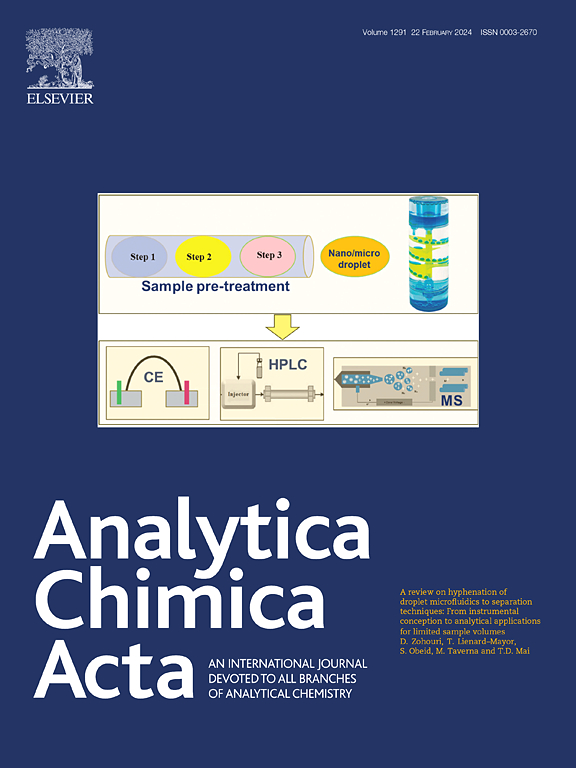基于级联激活的亚硫酸氢盐和铜离子双检测荧光传感器的重新设计
IF 6
2区 化学
Q1 CHEMISTRY, ANALYTICAL
引用次数: 0
摘要
级联激活探针由于其序列依赖性检测病理通路中的多个标记物而受到广泛关注。HSO3-和Cu2+是细胞内线粒体活性的生物标志物,同时检测它们具有重要意义。到目前为止,同时探测它们的探测器都是基于发射通道中带有“on - off - on”开关的位移机制。换句话说,使用HSO3-和Cu2+作为逻辑传感中的两个输入,(0,0)、(0,1)或(1,1)的输入给出相同的“1”输出。因此,他们在临床应用中受到假阳性信号的困扰。结果探索了具有更先进传感机制的荧光探针的从头设计。四种染料CM-Cu、CMA-Cu、R1和R2具有相似的结构,但它们的传感行为却有很大的不同。对于HSO3-和Cu2+的双重检测,CM-Cu表现出基于IMP逻辑门的“on - off - on”发射开关;CMA-Cu多1个醛基,首次基于AND门被级联激活。值得注意的是,与大多数双锁探针通常涉及复杂的合成过程不同,在这里,HSO3-和Cu2+的级联激活是通过调整现成结构的电子分布来实现的。CMA-Cu具有低毒性、高特异性、强固体发射和抗扩散能力,在数字加密和细胞成像方面的传感性能得到了验证。我们展示了如何通过微调分子结构来调整从位移到级联激活的双重识别。本研究为双锁探针的简单设计提供了新的思路,有助于对具有生理相关性的多种生物标志物进行序列检测,提高疾病诊断的准确性。本文章由计算机程序翻译,如有差异,请以英文原文为准。


De novo design of dual-detection fluorescent sensors for bisulfite and copper (II) ion based on cascade activation
Background
Cascade activated probes have received extensive attention due to their sequence-dependent detection of multiple markers in pathologic pathways. HSO3− and Cu2+ are biomarkers of intracellular mitochondrial activity, and their simultaneous detection is of great significance. Until now, probes that detect them simultaneously were all based on displacement mechanism with “ON-OFF-ON” switches in an emission channel. In other words, using HSO3− and Cu2+ as two inputs in logic sensing, the inputs of (0,0), (0,1), or (1,1) gave the same “1” output. Therefore, they suffered from the false positive signals in clinical application.
Results
The de novo design of fluorescent probes with a more advanced sensing mechanism was explored. The four dyes, CM-Cu, CMA-Cu, R1, and R2, have similar structures, but their sensing behaviors are quite different. For dual detection of HSO3− and Cu2+, CM-Cu showed emission “ON-OFF-ON” switches based on IMP logic gate; while CMA-Cu, having one more aldehyde, was cascade activated based on AND gate for the first time. Noteworthily, unlike most dual-locked probes, which usually involve a complex synthesis process, here, cascade activation by HSO3− and Cu2+ is achieved by adjusting the electron distribution of a ready-made structure. Coupled with its low toxicity, high specificity, strong solid emission, and anti-diffusion ability, the sensing property of CMA-Cu have been validated in digital encryption and cell imaging.
Significance
We exhibited how to adjust the dual recognition from displacement to cascade activation by fine-tuning the molecular structure. This study may provide a new idea for the simple design of dual-locked probe, which is helpful for the sequential detection of multiple biomarkers with physiological correlation and could improve the accuracy of disease diagnosis.
求助全文
通过发布文献求助,成功后即可免费获取论文全文。
去求助
来源期刊

Analytica Chimica Acta
化学-分析化学
CiteScore
10.40
自引率
6.50%
发文量
1081
审稿时长
38 days
期刊介绍:
Analytica Chimica Acta has an open access mirror journal Analytica Chimica Acta: X, sharing the same aims and scope, editorial team, submission system and rigorous peer review.
Analytica Chimica Acta provides a forum for the rapid publication of original research, and critical, comprehensive reviews dealing with all aspects of fundamental and applied modern analytical chemistry. The journal welcomes the submission of research papers which report studies concerning the development of new and significant analytical methodologies. In determining the suitability of submitted articles for publication, particular scrutiny will be placed on the degree of novelty and impact of the research and the extent to which it adds to the existing body of knowledge in analytical chemistry.
 求助内容:
求助内容: 应助结果提醒方式:
应助结果提醒方式:


